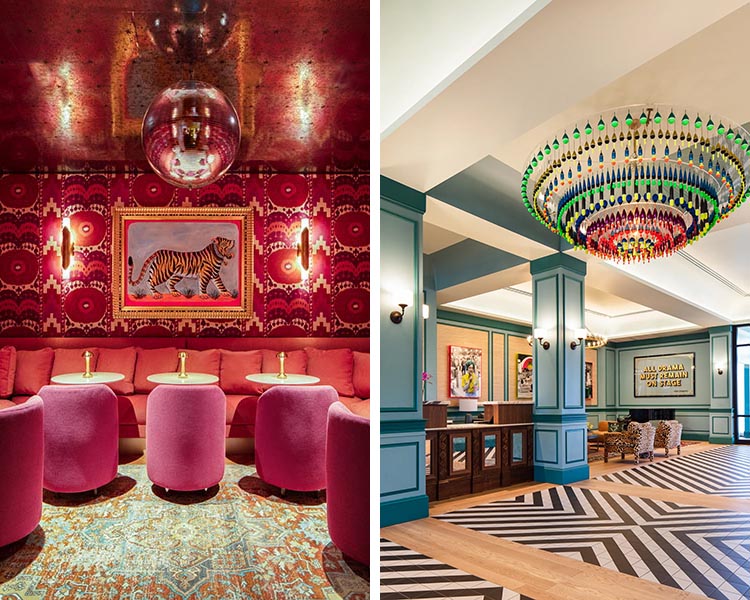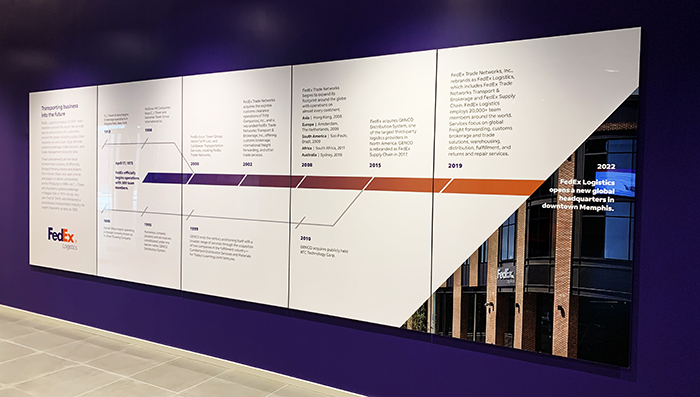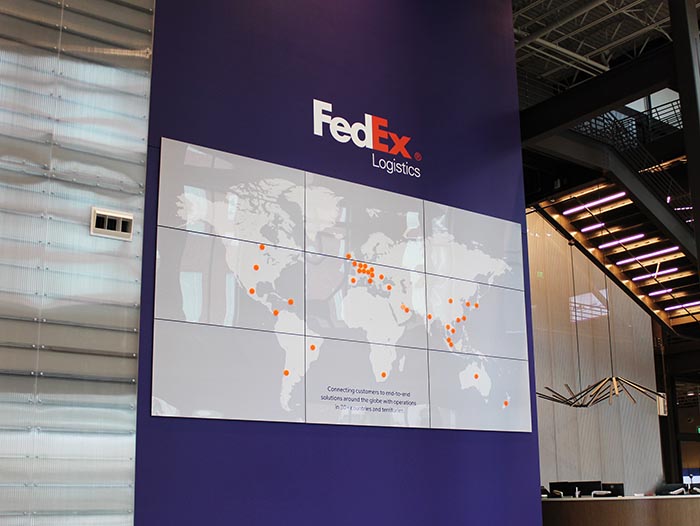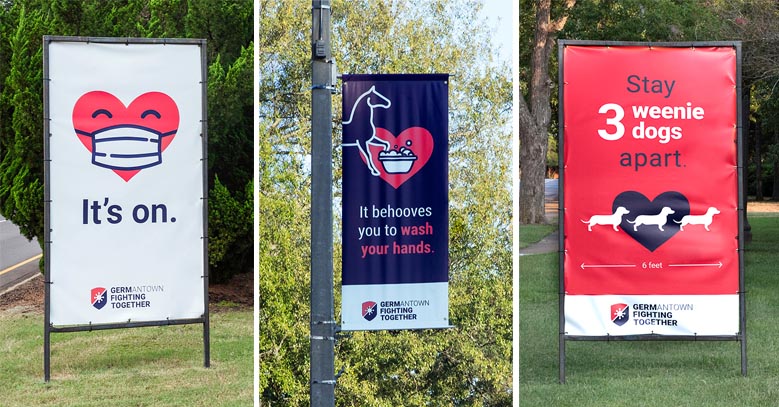On message strategy and more.
On message strategy and more.
What does your couch say about your brand?
A client walks into your office. How do they feel?
Before you cringe, no. This isn’t the start of a bad dad joke.
The way you arrange and decorate your hotel lobby or client lounge says a lot about your brand, and people notice.
Environmental branding is all about marketing your brand through interior and exterior design. Find out how it can help your brick-and-mortar business pop below.
Inspired by a boutique hotel’s environmental branding
I got the idea for this blog post during Counterparty 2022. As a remote employee, I stayed at the hotel near our Memphis headquarters called The Memphian.

Group photo of (left to right) Juliana, Cassidy, Carolina, & Sarah
My eyes glittered with the funky art and jewel-toned furniture throughout the building.
A canvas covered in rock candy, white alligator toys, and star-shaped stickers hung over one of the tables in the dining room. Wing-shaped amethyst rocks were set in front of a millennial-pink cloud backdrop. And a pillow featuring a nude ’60s era woman lying on lily pads sat on the chair in my hotel room.
I was starstruck, taking pictures for inspiration for my own home.

Credit source: Sélavie Photography via Condé Naste Traveler
I felt comfortable there. Unlike other hotels with the sad brown carpeting and outdated wallpaper, I felt spirited and energized to meet my fellow counterparts for breakfast in the eccentric dining room.
My experience of sleeping at the Memphian was elevated by the thought put into the interior design. It made it a memorable experience for me as opposed to the dozens of plain hotels I’ve stayed in before.
It got me thinking: What is this hotel trying to say about itself?
While researching my thoughts around this, I stumbled upon the idea of environmental branding.
Environmental branding definition
This form of marketing doesn’t have an official definition yet, or at least not by the American Marketing Association. But it has been explored by dozens of other marketing firms and agencies.
We unofficially define environmental branding as the physical manifestation of a brand’s identity through interior and exterior design.
Interior design is made up of furniture, walls, flooring, lighting, and even scent.
Exterior design catches your customers’ eyes as they drive by. Use your branding on signage, window displays, exterior paint, and door design.
Note that environmental branding is different from sustainable branding, in which a company “integrates environmental, economic, and social issues into its business operations.”
Environmental branding is part of your brand’s experience, as shown by this very-important-quote from Journal of Marketing:
And branding isn’t just for corporate spaces. It applies to hotels, restaurants, and other hospitality businesses, as well as retail businesses. Any business, big or small, has a message to share.
4 reasons why environmental branding is important
Your website is branded for user experience. If you have a brick-and-mortar location, then you should consider taking your UX to your building, too. Here’s why.
- Putting your brand at the forefront of your design differentiates you from the competition. You’ll be more memorable. And it communicates that you want your customers to feel good (happy, energetic, calm, or whatever your brand is) when they visit you.
- It turns a simple visit into an elevated experience. People love taking pictures of unique spaces to show friends on social. Free advertising.
- Environmental branding boosts employee morale and spirit. Artistic, thoughtful environments are shown to improve employees’ moods. Science says that when we look at art, blood flow to the brain increases by as much as 10 percent. So, depending on the vibe you are going for, not only are you giving your employees a better place to work, but you’re helping them work better, too.
- It also reinforces your message and purpose to your team. Show and tell your message to your staff.
How to get started with environmental branding
In order to get your environmental branding right, you need to nail down your message in general.
Consider these five key branding points. Each one is an opportunity for you to show your customers that you are a worthwhile competitor.
 Credit source: giphy.com
Credit source: giphy.com
- Brand identity: vision, mission, differentiation, and company values
- Message strategy: tagline, positioning, copy, and promise statement
- Visuals: color scheme, graphics, logos, and mascots/characters/key people
- Offerings: products and services
- Experience: customer service, UX/UI, and social media
See how some of Counterpart’s clients handled their environmental branding.


FedEx Logistics bought a new building that used to be owned by Gibson Guitar Factory in downtown Memphis, complete with high ceilings and exposed beams.
FedEx came to Counterpart asking for help to bring the new headquarters to life, promote the brand, and reinforce employee pride.
“We worked with the FedEx team to design and install large wall-size display graphics demonstrating their global reach and a historical timeline of FedEx,” says Susanne Beaumont, the project supervisor for the installation. “We used the classic FedEx brand colors as well as gray on sleek metal sheets to match the industrial interior of the building.”

Another client, the City of Germantown, wanted to create a COVID-19 campaign to promote CDC mandates. But instead of the ol’ “stay 6 feet apart,” they wanted a fresh take.
The campaign was an opportunity to share their message throughout the town streets. And they did it in a fun and uplifting way.
Lisa Pratt, the project supervisor for this campaign, said, “The City has a rich history with horses, and hosts a wiener dog race every year. By pulling these elements into their campaign, we helped to make a somber situation lighthearted while nodding to their past and present.”
Environmental branding is a key component to your company’s success
Create a distinct space that will stand out in your visitors’ minds. Your environment is one more message you’re sending to customers and clients, so it should follow the core principles of message strategy:
- Make them feel welcome. (Customer-centric)
- Instill confidence in your capabilities. (Compelling)
- Reflect your brand and driving messages. (Clear)
- Consider the physicality of the space and use it to your advantage. (Under control)
 Credit source: giphy.com
Credit source: giphy.com
Confused on how to build a brand in the first place? Not sure what makes a message effective? Counterpart can help with that. Give us a shout to craft your perfect message strategy. Or if you’re in Memphis, stop by the office. The ghost is part of the look.
Related:
The Strategy of Scent




